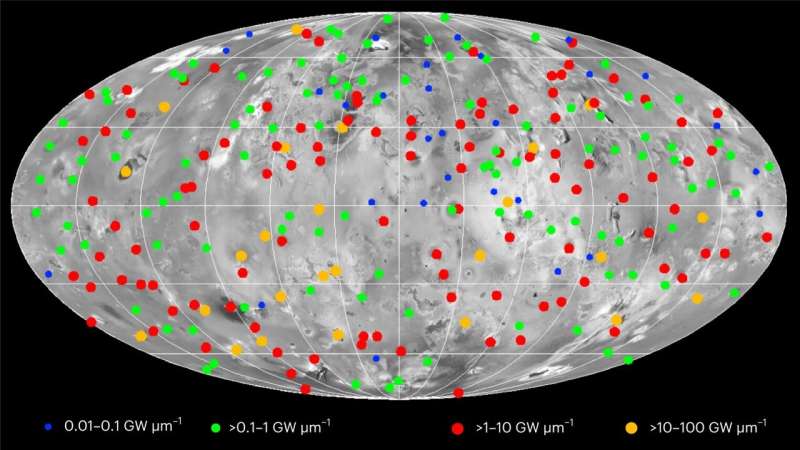November 21, 2023 report
This article has been reviewed according to Science X's editorial process and policies. Editors have highlighted the following attributes while ensuring the content's credibility:
fact-checked
peer-reviewed publication
trusted source
proofread
Global view of Io's volcanic activity suggests that tidal heating is concentrated within its upper mantle

A team of volcanologists and planetary scientists from NASA's Jet Propulsion Laboratory, California Institute of Technology, the University of Arizona, and Arizona State University has found via study of a newly created global view of Io's volcanic activity that its tidal heating is likely concentrated within its upper mantle. In their study, reported in the journal Nature Astronomy, the group analyzed data from sensors measuring heat emission from the closest of Jupiter's innermost moons.
Prior research has suggested that Io, one of Jupiter's moons, is the most volcanically active object in the solar system. Its surface is covered with caldera and red rivers of molten rock. Scientists would like to know the source of the heat driving this activity but have been unable to find the evidence they need.
They suggest the ultimate source is Jupiter's gravity—it exerts a changing pull on the moon due to changes in the distance of the moon from the planet. This results in friction in the moon's rocky material, resulting in heat production. What they do not know is whether the heat originates deep within the moon or closer to its surface. In this new effort, the researchers report evidence that suggests it is the latter.
Up until recently, most of the data regarding heat emission from Io have been focused on its equator—data from probes that passed near the moon and Earth-bound instruments have given scientists a lot of data for the moon's midsection but very little about its poles. Such data is needed, the research team notes, to learn more about where the underground heat is coming from.
In 2016, the Juno spacecraft began orbiting Jupiter around its poles, giving researchers studying Io a way to learn more about heat emanating from its poles, as well. The research team on this new effort was able to combine the new data with the old to create a global heat map for the entire moon.
They were able to map 266 volcanic hotspots and found that the moon was emitting 60% more heat along its lower latitudes than its higher latitudes—a characteristic of the moon that suggests the heat responsible for much of the volcanic activity is located just below the surface. If that is the case, the researchers suggest, it could mean that Io has a soft upper mantle or even a molten ocean beneath its crust.
More information: Ashley Gerard Davies et al, Io's polar volcanic thermal emission indicative of magma ocean and shallow tidal heating models, Nature Astronomy (2023). DOI: 10.1038/s41550-023-02123-5
Journal information: Nature Astronomy
© 2023 Science X Network





















